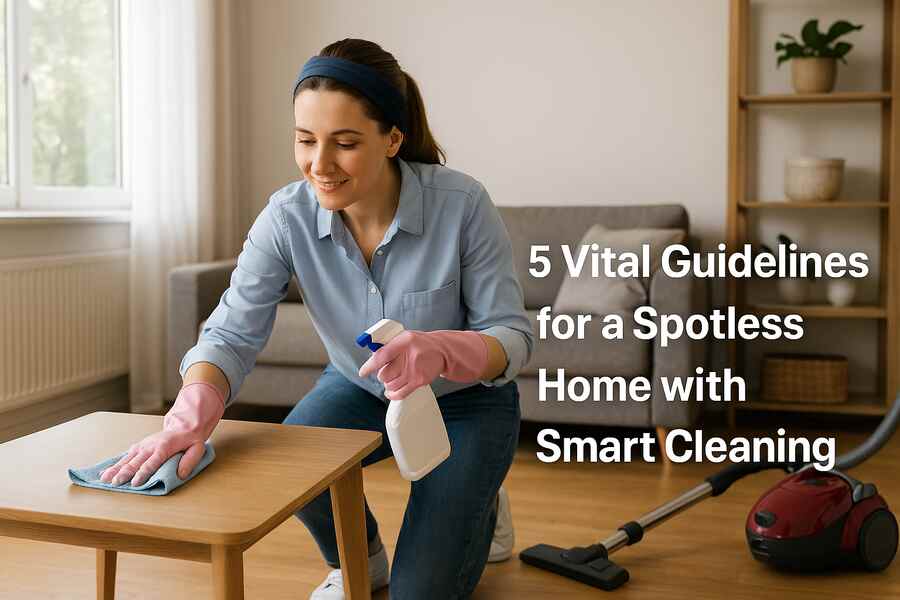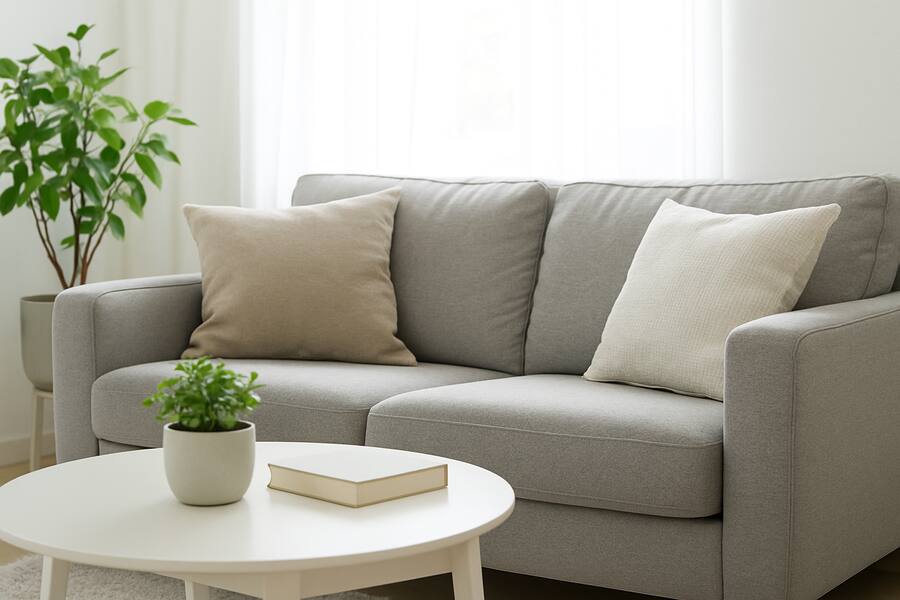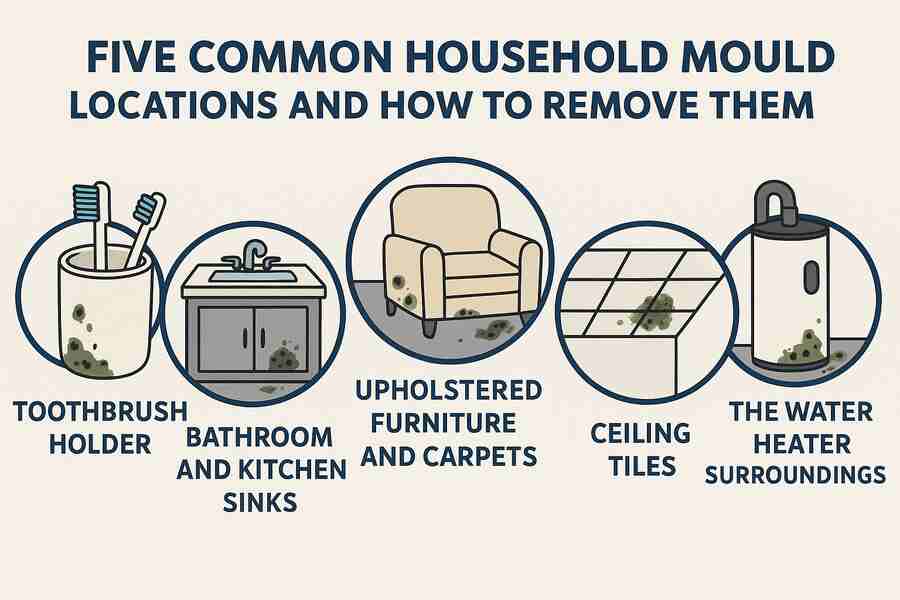5 Vital Guidelines for a Spotless Home with Smart Cleaning

5 Vital Guidelines for a Spotless Home with Smart Cleaning
Have you noticed sometimes you are doing nothing but cleaning but yet your house never seems to get the look of clean? And you wonder whether there is a more intelligent way of doing it–without wasting your whole weekend in scrubbing and dusting? What happens when the secret is not cleaning more but better?
Hello to smart cleaning! It takes only several golden rules to change your routine, spend less time, and always have all rooms look fresh. These are the five simple rules that will remind you not only how to become a tidy pro at cleaning but also how to avoid getting messy and grimy throughout the week, whether you are a tidy pro or a person who does not like doing chores.
Rule No. 1: Clean Before You Tidy Up
Remove 10 to 15 minutes of decluttering each of the rooms before you get the mop or vacuum. Use the left-behind items, put them in their rightful place, empty benchtops, and reduce the number of items that you put in plain view only to what is imperative. Just putting things away gives the impression that your room is already clean without you cleaning it.
The fact that it enables easy and quick dusting and wiping off, too makes it easier and quicker to do. In case you areorganisingg to do End of lease cleaning in Parkwood, cleaning up will ensure that you make every location accessible by the professional cleaners to enable you to get back your bond easily.
Rule No. 2: Start Cleaning Top to Bottom
Starting with the top and finishing in the lower part of every room is one of the best cleaning rules. Clean the ceiling fans, lighting fitments and shelves, then the furniture, then the skirting boards and finally the floor. This makes sure that whether I drop any dust or dirt in the process of cleaning upstairs, I will sweep or vacuum it at the end.
This is a way that saves you the time of redoing the work. Think of cleaning the floors and then dusting the shelves; all you are going to do is ruin the previously polished floor. To give comprehensive results, professionals will always do it as a top-down approach.
Rule 3: Multipurpose Cleaners Rule 3
It is not practical and economic to have a cupboard full of cleaners that are used to undertake minuscule tasks. Have a multipurpose cleaner that is of good quality, meaning it can be used on most surfaces, i.e. tiles, countertops, glass, and wood. It minimises the number of items you drag from one room to another, and cleaning becomes easy.
But be sure to always look at the label on the product before donningitm on the sensitive surfaces since this will prevent valuable damage. There are also some natural alternatives such as white vinegar, which can be the choice when you want to fight most grime and stains without harming them, so they become your clever way to clean.
Rule 4: Have a Cleaning Schedule
This is one of the reasons why people do not like cleaning, because they end up storing them all, so that it becomes a marathon. Rather, divide the cleaning into everyday and weekly chores. As an example, daily vacuuming and kitchen wipe-down are useful to maintain easy control of dust and grease. Then leave thorough cleaning of bathrooms, changing of sheets and mopping of floors to the weekends.
This is a habit that will leave your house clean at all times with minimal work. Additionally, since you may be required to clean your house in preparation for a rental inspection or even an end-of-lease clean service at any time, you will not have to resort to last-minute clean-ups, and you will not waste time or be stressed.
Rule 5: Do not ignore Hidden Spots
Usually, tenants clean those smaller components and floors, countertops that they see, while they neglect the places where dust accumulates the most, along with bacteria. It should be your rule to clean these out-of-sight spots at frequent intervals:
- Under and behind furniture- Rearrange the furniture by shifting sofas, beds and cupboards after intervals and brush off or mop the dust under them.
- Appliances in the kitchen- Clear out behind the fridge, under the microwave and the surrounding area of small appliances where crumbs and grease accumulate.
- Bathroom fixtures – Clean the back of toilets, taps and under sink cabinets to avoid mould and grime.
- Mattresses and curtains- Vacuum the surface of the mattress and wash or dust curtains and rods so as to avoid the allergens.
- Switchboards and corners- These get accumulated with an invisible form of dust over time; they should be cleaned by a quick wipe every week, and this makes them clean and hygienic.
During end-of-lease cleaning, these hidden areas are normally inspected, and by overlooking these areas, you can end up losing some of your bond money. To have a clean home that remains as spotless as possible, you have to prioritise them.
6. Bonus Tip: Air it Out
Clean means that the house is not musty, no matter how bright the surfaces are. When you do your cleaning, guarantee there is some fresh air by having your windows and doors open in your room. The natural air fresheners are essential oil diffusers, simmering cinnamon sticks, or having bowls of baking soda in the corners to counteract silent odours.
It not only makes your space smell fresh but also helps to improve air quality indoor,s making ia t healthier environment in which your family lives. Moreover, when you move out your landlord will welcome the clean, fresh atmosphere as well as shiny floors and windows.
Wrapping Up
Smart cleaning is the position of concluding, regularity and having tricks of the trade to make it easy on the pace of sweating more to say something. These five golden rules will help you to keep your house clean day by day and accomplish a task like end-of-lease cleaning without any problems. Because, you see, it is not all about how pretty a home is, but more of a tranquil place where you and every visitor that enters your home can feel welcome.



